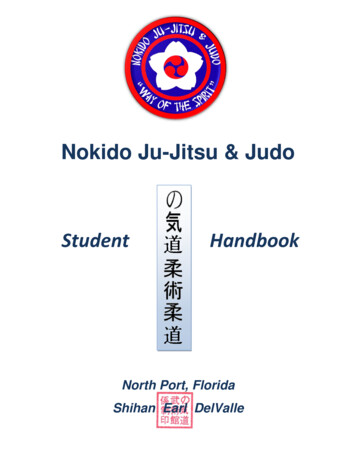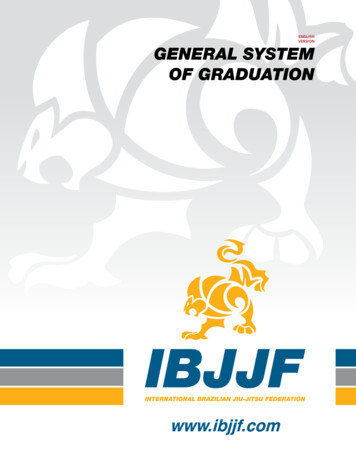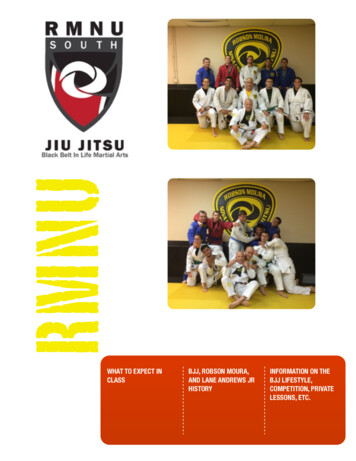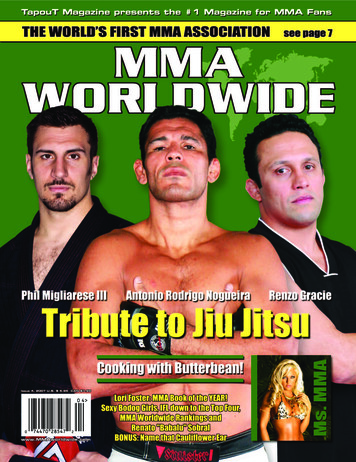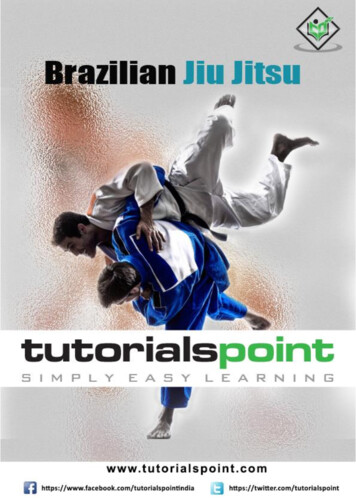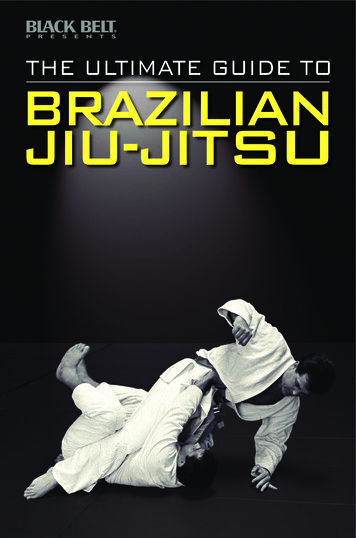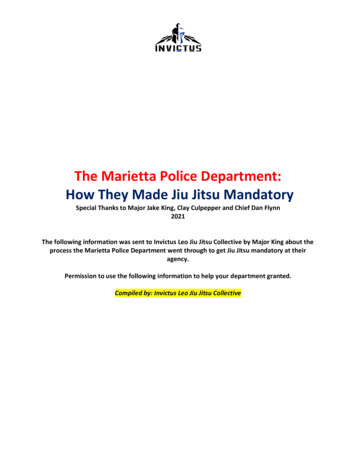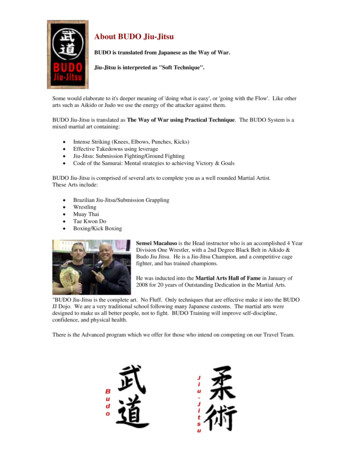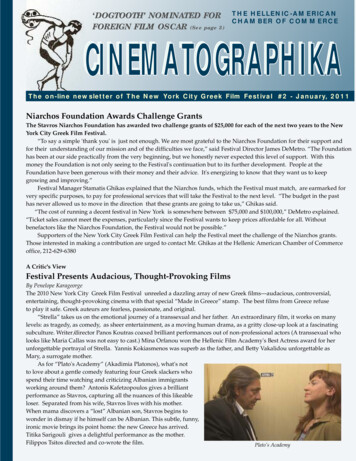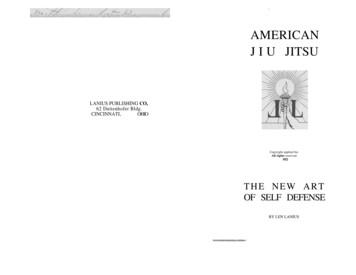
Transcription
AMERICANJ I U JITSULANIUS PUBLISHING CO,62 Duttenhofer Bldg.CINCINNATI,OHIOCopyright applied fur.All rights reserved.1922THE NEW ARTOF SELF DEFENSEBY LEN LANIUS. lllllllllin
American Jiu-JitsuLen Lanius, originator of American Jiu Jitsu, and author of this book, is aliving example of the value of physical training and of the efficiency of the system heteaches. Early in life he developed himself from a sickly lad into one of the mostnoted athletes of two continents, holding the lightweight wrestling championship ofthe world for a number of years. During his career he defeated antagonists of amuch heavier class than that in which he was rated, and it was in meeting theselarger men that he developed original methods of offense and defense that weregradually elaborated into the system of American Jiu Jitsu of today. The success ofthese earlier experiments in a smaller man overcoming a larger by a scientificuse of whatever strength he might possess, encouraged Mr. Lanius to make acomplete and thorough study of this work, which eventually reached the stage atwhich it could be, and is, demonstrably successful against any system of a similarnature.F, as we have been taught to believe, "Self preservation is thefirst law of Nature," then man is guilty of greater violation of thisinitial statute on the book of rules of our common mother than ofalmost any other commandment credited to this wise old lady.Nature has been bountiful in the matter of providing means of selfpreservation; but man has taken little advantage of this generosity, withthe result that there are conditions continually arising where self preservation, in the way of self protection, is called for, with man unprepared tomeet them.This fact finds its greatest demonstration in the ease with which thecriminal classes have been able to ply their preying trade upon thegeneral public, during the past few years particularly, with comparatively little or no resistance from the victims.Why?Because the victims were unprepared to meet these assaults — hadnot learned the first passage in the law of self preservation — the rule ofself protection — and so were practically helpless in the hands of theirassailants.This condition should not exist; and it would not exist, if thegeneral public could be made to realize that they are not helpless tomeet such emergencies — that the story of David and Goliath, broughtup to date in the matter of matching science against brute strength, is afact and easy of demonstration.The compiling of this little volume firmly establishes the fact thatall persons, regardless of sex, can train themselves in this system ofself defense in a manner that will be most effective in any emergency,giving not only self protection, but self confidence to the user.For years the author has given a close study to the development ofthis system of self protection, which he has named American Jiu Jitsu.The work is strictly of American origin, although the Japanese term JiuJitsu is used in the title. The author has used this term because of itsmeaning — bone breaking or muscle wrenching as this is the form ofpunishment that is used to overpower and bring an opponent undersubmission.This system has been built up step by step and much thought andcareful study has been given to devising its most practical and important features — personal protection without danger of personalinjury.
Naturally the reader will ask, "Can I learn this course?" "Can Imaster this system?" "Can I become strong enough to defend myself?""Will I accomplish a definite and beneficial result?" The answer toeach of these questions is strongly in the affirmative, the only provisobeing a careful study of this work and a sufficient amount of practice.The following tenets and rules of American Jiu Jitsu as here set forthwill enable one to attain self confidence — health and strength — tomeet emergencies fearlessly and to overcome mental as well asphysical dangers with the serene assurance of having the advantage andbeing the master of the situation.GENERAL INSTRUCTIONSFirst, secure a partner, preferably some friend who is interestedand will practice with you; however, any member of the family willdo.Alternately take the role of victim and aggressor. Unresistinglyallow each trick to be practiced on you until its full force may be felt;in turn practice it on your partner.Execute the beginning of the trick quickly, but the final actionslowly. This will give you a chance to note your power and guardagainst possible injuries.All practice should be formal, not competitive; once you startwrestling in a haphazard way, it will hinder your progress in learning.Your partner is aware of what you wish to try, but should not takeadvantage of this knowledge.Compare your poses with each illustration until you have fullymastered the positions. Remember that in learning, it is not speed thatcounts, but getting the full control of the body and the art of applying itsforce.Work very slowly at first and note the position of your body thatgives you the greatest power.Uniformity in strength is very essential in practice. The largerand stronger should tone down his strength to equal that of his partner.This will make the exercise more interesting and beneficial.This system of defense is so devised that any woman can practice itwith safety. In fact, a woman having this knowledge can not only defendherself against a ruffian, but will retain her presence of mind and keepcool in any emergency. With careful study and practice it can befully mastered within a short time; but the more you go through thepractice the greater will be your power in the use of your body and themore confidence you will develop within yourself.AMERICAN JIU JlTSUPART I — LESSON No. 1POSITION OF BODYTo successfully learn the art of overpowering others who may belarger and stronger, it is necessary that you understand the differentpositions of the body, which willgive you the greatest power eitherfor defense or attack.POSITION OF DEFENSEAssuming you are now ready tostart: Stand in your normal positionand have your practice partner pushyou by placing both of his hands onyour shoulders. Notice how easilyyou may become unbalanced. Nowtake the following position; stepback with one foot and bend slightlyat the knees; lean forward, tensingthe muscles of the abdomen and rearleg. (See illustration No. 1 . )Have your partner push you again.You will notice that you haveIllustration No. 1greatly increased your resistive power, and that itrequires considerable more force to cause you to become unbalanced.The position of defense not only aids you in warding off the impact ofyour opponent's strength, but places you in a position to make acounter attack. To take away the power of your opponent is easy toaccomplish, even though at first it seems difficult.Regardless of your strength, if you become unbalanced, yourpower to resist has been removed until you again secure the balancecontrol of your body. It is by taking advantage of this principle, thatmany of the locks and throws in this course are accomplished.
AMERICAN jiu JITSUAMERICAN JIU JITSUUNBALANCING BY RETREATPART I —LESSON No. 2PRELIMINARY PRACTICE IN LEG THROWSThat the principle of unbalancing and its many advantages maybe fully understood, we will start in the simplest way.Stand a short distance apart;have your partner reach as though toseize you around the waist; graspboth of his wrists firmly and quicklystep back to position of defense;pulling him forward and off balanceeither to your right or left. (Seeillustration No. 2.) Learn tounbalance in any direction as theoccasion may demand.Now practice unbalancing asyour partner reaches out witheither hand; should he reach withUnderstanding the advantage of learning to control your balance —of increasing your power through assuming the position of defense— and how to render useless thestrength of your opponent by unbalancing; we are now ready tomaster the important knowledge ofthe correct use of the feet and legs.Much of your power both as ameans of defense and attack islargely controlled by the correctuse of your feet. It is, therefore,essential, that you learn to useyour feet with as much confidence asyou would your hands.FRONT LEG THROWStart from your usual position,grasp your partner's right wristIllustration No. 2Illustration No. 4right, grasp his wrist with yourright, step back with right foot toposition of defense, pulling himforward and off balance to yourright side.turn your entire body to the right so that you are both facing thesame way. Step in front of him with your left foot and place your leftarm around his back, throw himforward over your leg by pullinghard on his right arm. (Seeillustration No. 4.)On many occasions this throwwill be used by violently swingingyour foot back and sweeping hisfeet from under him. Be sure andpractice this from both right andleft sides.UNBALANCING BY ATTACKTake position by grasping eachothers arms just below shoulders,now slip your right hand underpartner's left elbow and push upward,at the same time tighten your gripon his right arm and pulldownward. (See illustration No. 3.)Unbalance him by forcing him backand to the right. Reverse thispractice by pushing hisIllustration No. 3right arm up and unbalance by forcing him back and to the left.These are simple illustrations that show the ease in which onemay unbalance another.BACK LEG THROWStand facing your partner.Grasp his right wrist with yourleft hand. (See illustration No. 5.)Step back, pulling him so as tomake him step forward with theright foot. Quickly place your"* '*Illustration No. 5wit]1your
AMERICAN JIU JITSUAMERICAN JIU JITSUright foot behind his right and your arm around his waist;him backward over your leg.(See illustration No. 6.)throwAlso havePART I —LESSON No. 3your partner stand in an offguardBREAKING OPPONENT'SHOLD ON YOURWRISTposition with his feet close togetherand execute the same throw byomitting to pull him forward. Re-Have your partner grasp yourwrists. Turn your forearm so thatthe thin edge of your wrist (thumbside) faces the opening betweenhis thumb and first finger. Thisopening is the weakest point of hisgrip. Bring your elbows in closeto your stomach so as to use thefull power of the abdominalmuscles.verse this practice by making the onyour partne r's lef tthrow side.THE BACK HEELThe back heel is the most valuablemethod by which a throw can bemade with the feet.Face your partner in the usualmanner and grasp each othersarms at the shoulders; suddenlyplace your left hand under hisright elbow and unbalance him byWhip your hands up and out; thiswill break his hold. (See illustration No. 8.)Illustration No. 6Illustration No. 8pulling to your right side with theright hand and shove up on hiselbow with your left hand. Swingyour right foot violently striking yourpartner back of the knee joint withyour heel. (See illustration No. 7.)This will cause him to fall backward.Now reverse this entire position anduse the left foot to back heel.Lesson No. 2 is just preliminarypractice of the leg throws, andshould not be confused with theregular work. When instructed tofollow with the front leg throw orback heel, you should utilize only thepart as executed with the feet.BREAKING HOLD ON WRISTBY USE OF FULCRUMTwist arm till thin edge of yourwrist is toward the opening between his thumb and fingers.Pry your wrist out of his grip bytensing your arm and pushing yourelbow around to his elbow, using theedge of his hand as a fulcrum for aleverage.Illustration No.7Swing toward him so as to use theforce of your body back of yourarm. (See illustration No. 9.)Illustration No. 9
AMERICAN JIU JITSUAMERICAN JIU JlTSU10PART II — LESSON No. 1 SIDEARM TWIST AND BACK HEELHaving mastered the rudimental instructions which demonstrate themethods of unbalancing your opponent and of concentrating your ownstrength you are ready to practicethe locks, throws and breaks ofAmerican Jiu Jitsu. Take first theside arm twist and back heel,which will readily show the advantage of combining rapid thoughtand action — of unbalancing andconcentrating your strength.Have your partner reach asthough to seize you around thewaist, and as he does so, firmlygrasp his thumb, with your fingersto the palm of his hand. (Seeillustration No. 10.) Step backas described in position of deniustration No. 10fence and at the same time reenforce your left hand with your right by firmly grasping the otherside of his hand.Take away his strength by unbalancing, and by twisting the armyou can inflict much punishment. You are now in position to throwyour opponent by swinging yourright heel quickly against the back ofthe knee joint of his left leg. (Seeillustration No. 1 1 . )Practice this a few times untilyou have thoroughly mastered theprinciple of unbalancing, of punishing with the arm twist and usingthe back heel. After he is down youcan continue to punish by bendingthe wrist and twisting the arm as inIllustration No. 1 2. In practice careshould be taken not to back heelyour partner too hard, as thiscontrols the force of the fall.Reverse this grasping your partner'sleft hand with your right.*Illustration No. 1 1nBe sure to practice this on each other so that you can better understand the full effect.Illustration No. 12PART II —LESSON No. 2CROSS ARM BREAK AND BACK THROWThis trick of defence can always be used regardless of the strength ofyour opponent, and is excellent training in combining rapid thoughtand action. After youlearn to execute this tricksuccessfully you will realizethe subtle power of having aclear plan of action.Have your partner reachto seize you around thebod y. Step back withyour right foot, leanf o r w a r d a n d d r a w i n thestomach. Cross your arms,right over left, and graspyour partner's wrists. (SeeillustrationNo.13.)Suddenlypullhisarmsto aIllustration No. 13cross position so that his
AMERICAN JIU JITSU1213AMERICAN JIU JITSUright arm at e
Len Lanius, originator of American Jiu Jitsu, and author of this book, is a living example of the value of physical trainin g and of the efficiency of the system he teaches. Early in life he developed himself from a sickly lad into one of the most noted athletes of two continents, holding the lightweight wrestling championship of the world for a number of years. During his career he defeated .
